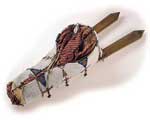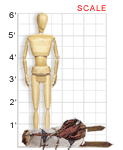VAM galleries including this work:
The Speed Art Museum | Everyday Life | Art Through Time | Young at Art || VAM Home
Native American, Southern Cheyenne
CRADLE WITH TURTLE NAVEL AMULET, c. 1890
Beads, trade cloth, wood, brass, bells, metal, hair; 46" X 13" X 9"
Gift of Frederick Weygold, 1937.68.29
The Speed Art Museum
A nomadic Cheyenne child would have spent much of the first two years of life in a portable cradle like this one. The cradle efficiently combined functions of a crib, playpen, and high chair. In addition, it often had a beaded charm attached to it that would have served as the child’s first plaything. In this cradle, the beaded turtle charm served to amuse as well as to act as a charm for the child’s protection and security. The charm is a navel amulet, which held a small piece of the baby’s umbilical cord. Always carried by the individual, such a charm protected the child throughout life and was a reminder of life before birth and the connection with the mother. The turtle is believed to have been associated with Mother Earth, the protection of children, and is one of the most common shapes used for navel amulets.
About the Artist
Lineage-based groups are made up of individuals who are all related through a single parent, either the father or the mother. All of the members of the group trace their shared ancestry to a single person. This shared heredity lends stability to lineage-based groups, since the shared ancestry is a permanent connection between individual members of the group. Understandably, a lineage-based group is primarily exclusive in its membership, and its related members hold both particular rights and responsibilities within the group. The Cheyenne of North America are one such lineage-based group.
Before 1700, the Cheyenne lived in central Minnesota as farmers and hunters. Over the next century, warfare and disease pressured them to migrate numerous times. During the 19th century, the Cheyenne settled around the headwaters of the Platte River in the central Plains region and became buffalo hunters. The tribe was divided into northern and southern branches in 1832, when a large segment of the group was located along the Arkansas River.
The Native American peoples of the Plains region, including the Cheyenne, were nomadic buffalo hunters. The buffalo was a primary source not only of food but also of much of the tribe’s clothing, containers, tools, and tepees. The migratory culture of the Plains people developed around the seasonal movements of the buffalo. The late 19th century saw the Cheyenne engaging in raids and wars against settlers as they began to threaten the land, resources, and freedom of the Native Americans.
Since the Cheyenne were nomadic, it was important for their possessions to be both functional and portable. Many objects intended for use in daily life were enhanced with rich surface decoration, such as the rich beadwork on this cradle cover. In addition to being visually pleasing, decorations like the turtle charm attached to this cradle could convey powerful symbolic meanings.
Classroom Ideas
Discussion: What would life have been like for the baby who used this cradle? Do you see any similarities between this portable baby carrier and ones used today, such as car seats? What kinds of playthings are used to amuse infants today, and how do they compare to the turtle amulet? Why do you think a turtle might be considered a protective symbol for a child?
Activities: In groups, research aspects of traditional and contemporary Cheyenne culture. Create posters or presentations to report your findings.
Explore the art of beading. Does contemporary American culture use beads for artistic and/or decorative purposes? Thread small beads and sew them to squares of cloth in a design. Based on that experience, how long do you think it would have taken to create an elaborately beaded item like this cradleboard?
Links
You’ll find numerous links to information about Cheyenne language, history, and culture at the Native Languages of the Americas web site.
[www.native-languages.org/cheyenne.htm]
The Buffalo Bill Historical Center’s Plains Indian Museum has lots of background about Plains cultures and American Indian artifacts.
[www.bbhc.org/pim/]

